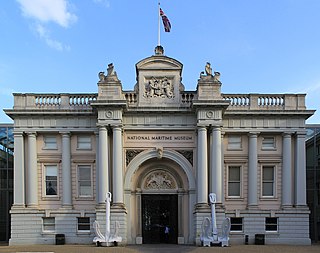
The National Maritime Museum (NMM) is a maritime museum in Greenwich, London. It is part of Royal Museums Greenwich, a network of museums in the Maritime Greenwich World Heritage Site. Like other publicly funded national museums in the United Kingdom, it has no general admission charge; there are admission charges for most side-gallery temporary exhibitions, usually supplemented by many loaned works from other museums.

English art is the body of visual arts made in England. England has Europe's earliest and northernmost ice-age cave art. Prehistoric art in England largely corresponds with art made elsewhere in contemporary Britain, but early medieval Anglo-Saxon art saw the development of a distinctly English style, and English art continued thereafter to have a distinct character. English art made after the formation in 1707 of the Kingdom of Great Britain may be regarded in most respects simultaneously as art of the United Kingdom.

Cannon Hall is a country house museum located between the villages of Cawthorne and High Hoyland some 5 miles west of Barnsley, South Yorkshire, England. Originally the home of the Spencer and later the Spencer-Stanhope family, it now houses collections of fine furniture, paintings, ceramics and glassware. It at one time housed the Regimental Museum of the 13th/18th Royal Hussars and the Light Dragoons, which has now closed. Now occupying four rooms in the east wing is the "Family of Artists" exhibition on loan from the De Morgan Foundation, which draws on the links between the Spencer Stanhopes and the De Morgans.

Nicholas Pocock was an English artist known for his many detailed paintings of naval battles during the age of sail.
Sir Richard Sheridan Franklin Bowling, known as Frank Bowling, is a Guyana-born British artist. His paintings relate to Abstract expressionism, Color Field painting, and Lyrical Abstraction.
Sir William Russell Flint was a Scottish artist and illustrator who was known especially for his watercolours of women. He also worked in oils, tempera, and printmaking.
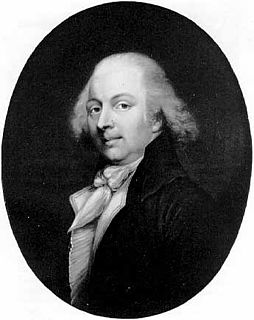
John Webber was an English artist who accompanied Captain Cook on his third Pacific expedition. He is best known for his images of Australasia, Hawaii and Alaska.

Edward William Cooke was an English landscape and marine painter, and gardener.

Alan Ernest Sorrell was an English artist and writer best remembered for his archaeological illustrations, particularly his detailed reconstructions of Roman Britain. He was a Senior Assistant Instructor of Drawing at The Royal College of Art, between 1931–39 and 1946–48. In 1937 he was elected a member of the Royal Watercolour Society.
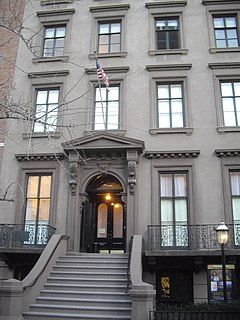
The Salmagundi Club, sometimes referred to as the Salmagundi Art Club, is a fine arts center founded in 1871 in the Greenwich Village section of Manhattan, New York City. Since 1917, it has been located at 47 Fifth Avenue. As of 2021, its membership roster totals roughly 1,100 members.
Montague Dawson RSMA, FRSA (1895–1973) was a British painter who was renowned as a maritime artist. His most famous paintings depict sailing ships, usually clippers or warships of the 18th and 19th centuries.
Thomas Whitcombe was a prominent British maritime painter of the Napoleonic Wars. Among his work are over 150 actions of the Royal Navy, and he exhibited at the Royal Academy, the British Institution and the Royal Society of British Artists. His pictures are highly sought after today.

Samuel Scott was a British landscape painter known for his riverside scenes and seascapes.
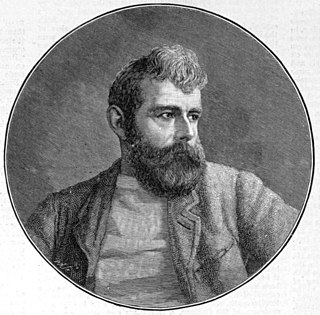
William Lionel Wyllie also known as W. L. Wyllie was a prolific English painter of maritime themes in both oils and watercolours. He has been described as "the most distinguished marine artist of his day." His work is in the Tate, the Royal Academy, the Imperial War Museum, the National Maritime Museum, the National Museum of the Royal Navy, and many other institutions around the world.
William John Huggins was a British marine painter who won royal patronage for his work.
John Stanton Ward CBE was an English portrait artist, landscape painter and illustrator. His subjects included British royalty and celebrities.

James John Wilson Carmichael, also known as John Carmichael was a British marine painter.
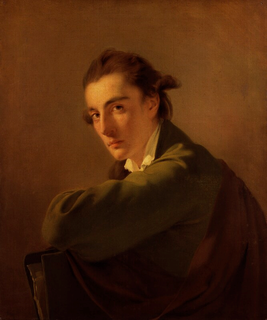
Richard Hurlstone or Richard Hurleston was a British portrait painter known for being a pupil of Joseph Wright of Derby. He went to Italy with Wright and his wife. He returned and died young after being hit by lightning on Salisbury Plain.
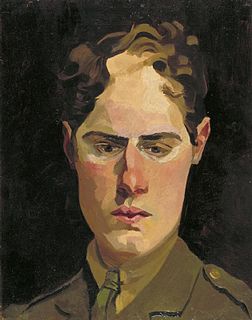
Richard Cotton Carline was a British artist, arts administrator and writer. During the First World War, Carline served on the Western Front and in the Middle East, where he travelled extensively through Palestine, Syria, India and modern day Iran and Iraq. Although known for his depictions of aerial combat painted during World War One, from the mid-1930s, his output as an artist was overshadowed by his numerous roles in local, national and international artists' organisations. Carline held strong anti-fascist beliefs and also worked to gain appreciation for African art, naive art, child artists and even promote the artistic merits of postcard images.
William Ball Spencer (1854-1923) was a British marine painter. He was the son of Richard Ball Spencer.















